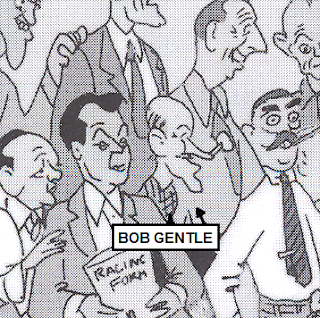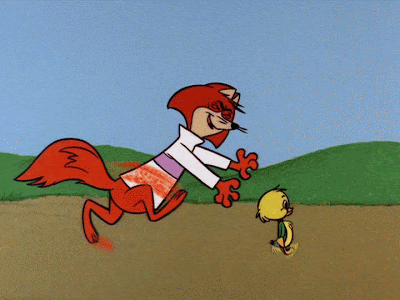Produced and Directed by Bill Hanna and Joe Barbera.
Credits: Animation – Bill Keil, Layout – Tony Rivera, Backgrounds – Dick Thomas, Written by Warren Foster, Story Director – Alex Lovy, Titles – Art Goble, Production Supervision – Howard Hanson.
Voice Cast: Yogi Bear – Daws Butler; Ranger Smith, Boo Boo – Don Messick; Iron Hand Jones – Doug Young.
Music: Hoyt Curtin.
First aired: 1961-62 season (rerun, week of Nov. 26, 1962).
Plot: Yogi tries to outwit a fill-in, disciplinary ranger, Iron Hand Jones.
Warren Foster became a master of the 6½-minute sitcom on the Yogi Bear series. In his better cartoons, he knew how to stretch a storyline just long enough, climax it, then come up with a little tag on the end. His best cartoons had satire woven in which, unfortunately, wasn’t often enough.
The “Iron Hand Jones” plot is put together very nicely. There aren’t a lot of yuks but the viewer’s hooked to see how, or if, Yogi will work his way out of his latest predicament. In this cartoon, he does. But he outsmarts himself and is back where he started as the cartoon fades out at the end. This fit Foster’s philosophy about how the Yogi series should be written. He once told the New York Times“[T]here is the problem of what to do about the morality of thievery. So we let him [Yogi] get his picnic basket—and then we get him punished.”
This is also another cartoon where Ranger Smith is a complete jerk at the beginning. Smith admits later in the cartoon “Yogi’s a problem but he’s not a bad bear.” Later, he calls him “my favourite bear” (ahead of Boo Boo?!). But when Yogi goes into his office to ask what’s going on, Smith snaps “Yogi, at any other time, I’d resent your insolence.” Geez, Ranger Smith, he was just asking a question. This is how you treat your favourite bear? Anyway, the deal is the ranger is going on holidays and being replaced for the duration by Iron Hand Jones, a former paratrooper. He’s not called Iron Hand for nothing, he tells us, and smashes his fist into his hand, with the camera shaking and a clang noise filling the soundtrack. Jones decides to whip Yogi into shape (he likes “well-conditioned bears, with nice shiny coats”). My favourite little bit is when Iron Hand orders Boo Boo out of the ranger station. Boo Boo finds the quickest exit. He jumps through the window.
![]()
![]()
![]()
Before long, Jones has Yogi quick-time marching around the park. “I don’t remember signin’ anything but, somehow, I’ve joined the army.” So he concocts a clever plan. He leaves a path of bear tracks to a lake and places his hat at the edge. “It can only lead to one conclusion,” he tells us, “There’s one less bear in the army.” And that’s the conclusion Ranger Smith reaches when he gets back, though Yogi has actually just hoisted himself into a tree next to the lake (or, as he puts it, “a friendly tree is the place for me”).
![]()
![]()
Smith kicks Iron Hand out of the park for driving Yogi “to a watery you-know-what.” The phone rings. Picnic baskets are disappearing by the lake. “Yogi has figured out a way to strike from beyond the Twilight Zone,” he determines. It’s a shame licensing issues (and money) prevented what would have been a great musical gag—using the Twilight Zone theme as an accent. Instead, we get Hoyt Curtin’s xylophones and woodwinds that toddle along during the whole scene.
Smith goes to the lake and addresses Yogi in “that Jellystone in the sky”. “You’re welcome to any picnic baskets you can get, Yogi,” he promises. But when Yogi appears, Smith becomes a jerk again. Evidently bitter that he’s been deceived, the cartoon ends with Yogi quick-time marching around the park (to “The Flintstones” theme in march time). “It seems to me I should have stayed in my tree,” he tells us as the cartoon ends. The whole tree thing is a little odd if you stop to think about it. For one thing, Yogi is sitting in the branches with four, full picnic baskets. You mean he’d leave them untouched during the whole time four sets of tourists would lunch under the tree? And if he’s in the tree, why does he walk into the scene from the right side of the frame? Well, the baskets are needed in the tree to emphasize the story, and it was probably easier animating a walk cycle than a climb (and certainly takes up less screen time).
![]()
![]()
![]()
Bill Keil is the animator in this cartoon. He draws dialogue in profile with the mouth—and in Yogi’s case, the snout—slightly to the side (you’ll notice a line leading from Yogi’s nose to the mouth that you wouldn’t see in a true profile). That means he animates mouth movements on the face, but he does raise Yogi’s nose for a bit of variety).
![]()
There seem to be occasional shot-matching problems at H-B. Here are consecutive frames. When the camera switches to a medium shot of Ranger Smith and Iron Hand Jones, they’re in different positions than the longer shot.
![]()
![]()
Dialogue:
Jones: So, you call yourself a bear, eh?
Yogi: If I’m not, it’s a pretty good disguise, right, sir?
Jones: Quiet!!!
Here’s Keil’s reaction drawing.
![]()
As mentioned earlier, you’ll hear what later became the Flintstones theme in the cartoon, including when Smith is puttering along (there’s a putter sound effect) in his 1961 Rivera Jeep (Tony Rivera, that is). Dick Thomas adds a bit of colour in the main background with some flowers in addition to his usual scratchy grass and bushes that are angled to the right.
Credits: Animation – Bill Keil, Layout – Tony Rivera, Backgrounds – Dick Thomas, Written by Warren Foster, Story Director – Alex Lovy, Titles – Art Goble, Production Supervision – Howard Hanson.
Voice Cast: Yogi Bear – Daws Butler; Ranger Smith, Boo Boo – Don Messick; Iron Hand Jones – Doug Young.
Music: Hoyt Curtin.
First aired: 1961-62 season (rerun, week of Nov. 26, 1962).
Plot: Yogi tries to outwit a fill-in, disciplinary ranger, Iron Hand Jones.
Warren Foster became a master of the 6½-minute sitcom on the Yogi Bear series. In his better cartoons, he knew how to stretch a storyline just long enough, climax it, then come up with a little tag on the end. His best cartoons had satire woven in which, unfortunately, wasn’t often enough.
The “Iron Hand Jones” plot is put together very nicely. There aren’t a lot of yuks but the viewer’s hooked to see how, or if, Yogi will work his way out of his latest predicament. In this cartoon, he does. But he outsmarts himself and is back where he started as the cartoon fades out at the end. This fit Foster’s philosophy about how the Yogi series should be written. He once told the New York Times“[T]here is the problem of what to do about the morality of thievery. So we let him [Yogi] get his picnic basket—and then we get him punished.”
This is also another cartoon where Ranger Smith is a complete jerk at the beginning. Smith admits later in the cartoon “Yogi’s a problem but he’s not a bad bear.” Later, he calls him “my favourite bear” (ahead of Boo Boo?!). But when Yogi goes into his office to ask what’s going on, Smith snaps “Yogi, at any other time, I’d resent your insolence.” Geez, Ranger Smith, he was just asking a question. This is how you treat your favourite bear? Anyway, the deal is the ranger is going on holidays and being replaced for the duration by Iron Hand Jones, a former paratrooper. He’s not called Iron Hand for nothing, he tells us, and smashes his fist into his hand, with the camera shaking and a clang noise filling the soundtrack. Jones decides to whip Yogi into shape (he likes “well-conditioned bears, with nice shiny coats”). My favourite little bit is when Iron Hand orders Boo Boo out of the ranger station. Boo Boo finds the quickest exit. He jumps through the window.



Before long, Jones has Yogi quick-time marching around the park. “I don’t remember signin’ anything but, somehow, I’ve joined the army.” So he concocts a clever plan. He leaves a path of bear tracks to a lake and places his hat at the edge. “It can only lead to one conclusion,” he tells us, “There’s one less bear in the army.” And that’s the conclusion Ranger Smith reaches when he gets back, though Yogi has actually just hoisted himself into a tree next to the lake (or, as he puts it, “a friendly tree is the place for me”).


Smith kicks Iron Hand out of the park for driving Yogi “to a watery you-know-what.” The phone rings. Picnic baskets are disappearing by the lake. “Yogi has figured out a way to strike from beyond the Twilight Zone,” he determines. It’s a shame licensing issues (and money) prevented what would have been a great musical gag—using the Twilight Zone theme as an accent. Instead, we get Hoyt Curtin’s xylophones and woodwinds that toddle along during the whole scene.
Smith goes to the lake and addresses Yogi in “that Jellystone in the sky”. “You’re welcome to any picnic baskets you can get, Yogi,” he promises. But when Yogi appears, Smith becomes a jerk again. Evidently bitter that he’s been deceived, the cartoon ends with Yogi quick-time marching around the park (to “The Flintstones” theme in march time). “It seems to me I should have stayed in my tree,” he tells us as the cartoon ends. The whole tree thing is a little odd if you stop to think about it. For one thing, Yogi is sitting in the branches with four, full picnic baskets. You mean he’d leave them untouched during the whole time four sets of tourists would lunch under the tree? And if he’s in the tree, why does he walk into the scene from the right side of the frame? Well, the baskets are needed in the tree to emphasize the story, and it was probably easier animating a walk cycle than a climb (and certainly takes up less screen time).



Bill Keil is the animator in this cartoon. He draws dialogue in profile with the mouth—and in Yogi’s case, the snout—slightly to the side (you’ll notice a line leading from Yogi’s nose to the mouth that you wouldn’t see in a true profile). That means he animates mouth movements on the face, but he does raise Yogi’s nose for a bit of variety).

There seem to be occasional shot-matching problems at H-B. Here are consecutive frames. When the camera switches to a medium shot of Ranger Smith and Iron Hand Jones, they’re in different positions than the longer shot.


Dialogue:
Jones: So, you call yourself a bear, eh?
Yogi: If I’m not, it’s a pretty good disguise, right, sir?
Jones: Quiet!!!
Here’s Keil’s reaction drawing.

As mentioned earlier, you’ll hear what later became the Flintstones theme in the cartoon, including when Smith is puttering along (there’s a putter sound effect) in his 1961 Rivera Jeep (Tony Rivera, that is). Dick Thomas adds a bit of colour in the main background with some flowers in addition to his usual scratchy grass and bushes that are angled to the right.












































































.png)
.png)
.png)
.png)





































































































